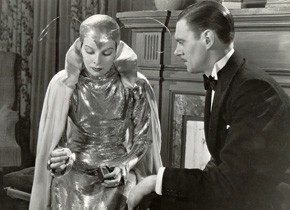Dorothy Arzner
March 18 to April 7, 2011
“My philosophy is that to be a director you cannot be subject to anyone, even the head of the studio.I threatened to quit each time I didn’t get my way, but no one ever let me walk out.”
Dorothy Arzner (1897-1979) was the only woman director with an extended career in the Hollywood Studio era and the first female member of the Directors Guild of America. Between 1927 and 1943 she directed sixteen feature films, some of which – especially Working Girls (1931), Merrily We Go to Hell (1932), Christopher Strong (1933), Craig's Wife (1936) and Dance, Girl, Dance (1940) – can be regarded as milestones not just of feminist filmmaking, but of popular cinema in general. To these should be added numerous works as an editor and screenwriter as well as (uncredited) jobs as a co-director: Arzner's reputation as a master of the craft was widely known and she was repeatedly entrusted with saving troubled productions.
Given her significant contributions to cinema and the emphatic rediscovery of her work by younger film critics in the 1970s, one would think that Dorothy Arzner’s place in any serious representation of film history is secure. However, in various standard film texts she either does not appear at all or is severely marginalized. One reason for this might be ignorance – for a long time, her films were not readily available and only a few were shown at some regularity. But there is another explanation: Arzner simply does not fit – her films, her image and her life bring much of what is commonly accepted into question.
For more than four decades, Arzner shared a house and bed with the choreographer and dancer Marion Morgan, who was also involved in some of Arzner's movies. Although nothing was spoken of it officially, everyone in Hollywood was well aware of Arnzer's sexual orientation. In publicity photos, she cultivated an edgy, domineering look, which could be read as butch – her hair plastered straight back, dressed in suits (with skirts instead of pants) and wearing neckties or similarly knotted scarves. In private photos, she did not always appear in this manner, and it is possible that her public image was also an attempt to represent the "man in charge" role of the director. At the same time, the Hollywood publicity machine stressed Arzner's affinity for women's pictures: even though she had demonstrated a fabulous feel for action as an editor (among others, with The Covered Wagon, directed by her mentor, James Cruze), she was mostly given material that was considered "proper" for a woman.
Still, it is not necessary to search beneath the surface of Arzner's films in order to discover their subversive dimension. Her critique of patriarchal society is often readily visible – in the iconic Clara Bow comedy The Wild Party as well as in the backstage musical Dance, Girl, Dance or in the open-minded and witty films that Arzner was able to make before the Production Code was enforced in 1934 (Honor Among Lovers with Claudette Colbert, Merrily We Go To Hell with Sylvia Sidney and Cary Grant, and Working Girls). Time and again, Arzner concerned herself with social borders and the dynamics of capitalism: class antagonisms are clearly articulated, relationships and institutions are thematized, and forms of solidarity are critically examined. Arzner presented heterosexual relationships of love, desire and convenience, which could also be applied to gender relations of all types. Lesbian undertones often swirled beneath the depiction of these relationships, but even in Pre-Code cinema these could never be more than hinted at.
With her unusually rich and contradictory female characters, Arzner (almost always in collaboration with female screenwriters) created dream parts for some of Hollywood's greatest divas: Ruth Chatterton in Sarah and Son and Anybody's Woman (both 1930), Katherine Hepburn in Christopher Strong, Rosalind Russell in Craig's Wife, Joan Crawford in The Bride Wore Red (1937) and Maureen O'Harain Dance, Girl, Dance. Many of these works found success with audiences and critics, but the director became more and more of an outsider in the Hollywood system. Her last film, the WW 2 Resistance drama First Comes Courage (1943), was completed by Charles Vidor after Arzner contracted a serious lung infection. Politically reactionary studio bosses like Louis B. Mayer and Harry Cohn probably contributed to the end of Dorothy Arzner's directing career – and, as she herself commented, twenty-five years in the business (and with business partners like that) were simply enough.
Arzner retired to the countryside but reemerged in 1960 as a greatly beloved teacher of the first "Film School Generation" at UCLA (which included Francis Ford Coppola). In 1975, she was honored by the Directors Guild in a gala celebration. The evening's organizer, director Francine Parker, summed up Dorothy Arzner's work precisely: "The world does take on a rather startling and surprising look when observed through the eyes of a skilled, talented, hard-working, learned and thoroughly unintimidated female.”
This most comprehensive retrospective-to-date of works by Dorothy Arzner is complemented by a research seminar taught by Andrea B. Braidt at the University of Vienna, Department of Theater, Film and Media Studies. Ms. Braidt will present on March 30 a lecture at the Film Museum and participate in a conversation via Skype with film historian and Arzner biographer Judith Mayne at the opening of the series.
Related materials


